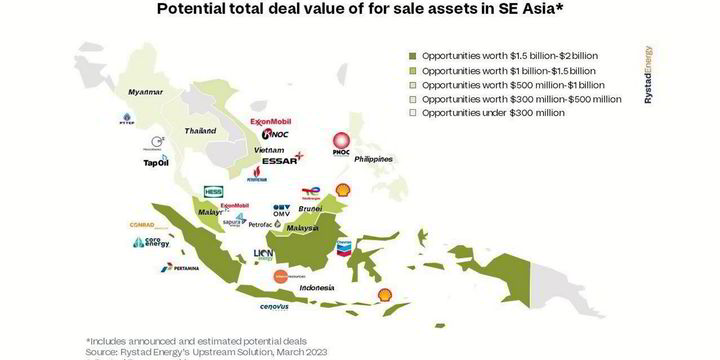Southeast Asia will be a hotbed for upstream mergers and acquisitions (M&A) in the next two years, with more than $5 billion of assets up for grabs, Rystad Energy research shows.
The majority of these opportunities are in Indonesia, where upwards of $2 billion of assets are on the market, followed by Malaysia and Vietnam — which have approximately $1.4 billion and $1 billion for sale respectively. Some $700 million of deals have already been completed in the region to date this year, the strongest start to Southeast Asia’s upstream M&A activity since 2019, according to the Norwegian consultant.
Assets with deals agreed and estimated potential deals include Shell’s 35% stake in Inpex’s Masela production sharing contract (Abadi project) and Chevron’s IDD project — both offshore Indonesia, takes in assets offshore Brunei held by TotalEnergies and Shell, PTTEP’s interests in Myanmar and stakes in assets offshore Vietnam held by ExxonMobil, KNOC and Essar.
Of all the assets up for sale, 74% are in the pre-final investment decision (FID) stage, 21% are already in production and the remaining 5% or so are under development.
In total, they represent some 4 million barrels of oil equivalent resources and production of around 270,000 barrels of oil equivalent per day with a gas-to-liquids ratio of 63:37, which Rystad describes as “a lucrative proposition for prospective investors”.
Lot of money changing hands
“There is a lot of money changing hands in Southeast Asia right now. The sheer magnitude of the oil and gas deals in the region will reignite the sector, reducing reliance on national oil companies (NOCs) and major players that has developed in recent decades. Southeast Asia presents an excellent opportunity for upstream players looking to strengthen their hydrocarbon portfolios,” said Prateek Pandey, vice president of upstream research, Rystad Energy.
Article continues below the advert
Fiscal and regulatory frameworks are said to play a significant role in encouraging M&A activity, helping to attract buyers and secure deals. The framework changes that Malaysia, Indonesia and Thailand have implemented in recent years are boosting interest from energy majors and other new regional buyers as these countries benefit from successful exploration results.
Other Asean nations such as Vietnam and Cambodia are said to be looking with envy at their neighbours and trying to enact similar processes to attract investments and deals. As a result of this fiscal loosening, a host of diverse oil and gas players are looking seriously at Southeast Asia as a pillar of their portfolio expansion plans, added Rystad.
The M&A opportunities expected to change hands are spread across the entire lifecycle, including producing, under development and newly discovered resources.
Malaysia leads the pack in terms of producing assets on offer with a 45% share of the regional total, with Indonesia the next largest at 27%. Discovered but not yet under development resources dominate the opportunities though, with almost 3 billion boe up for sale. Indonesia leads this category by quite some margin, boasting 1.6 billion boe of available resources, followed by Vietnam with 780 million boe and Malaysia with 460 million boe. Myanmar and Thailand also have discovered resources up for grabs.
Divestment rationale
The region’s M&A opportunities are boosted as oil major reduce their stakes in mature upstream assets and also look to divest challenging unexploited fields. Southeast Asian’s M&A potential is also being fuelled by regional NOCs’ desire to mitigate or reduce the vast capital expenditure required to maintain and operate mature blocks by bringing in technical partners to implement enhanced oil recovery projects.
“Overall, the confluence of these factors is shaping the M&A landscape in the region and creating opportunities for strategic buyers to capitalise on shifting dynamics in the industry,” added Rystad.
“Decommissioning costs, production sharing contracts’ expiry and time-to-development for pre-FID opportunities are dominating buyers’ thoughts as they screen M&A opportunities in the region. The objective of upstream companies has shifted from just expanding the reserves base to looking for already producing assets, with a preference for gas resources in countries with fewer policy and regulatory hurdles.”
M&A prospects that have the potential to support carbon capture and storage (CCS) and utilisation efforts or facilitate decarbonisation initiatives are expected to prove particularly attractive to large international players and local NOCs, noted the consultant.
Regional experts and European independents will remain active participants in the market as they look to take advantage of deals on the table to expand their presence in Southeast Asia.
Also, the “allure of fiscal adjustments, exploration success and concerns over energy security” will likely stimulate the interest of global oil and gas players and international oil companies, concluded Rystad.

